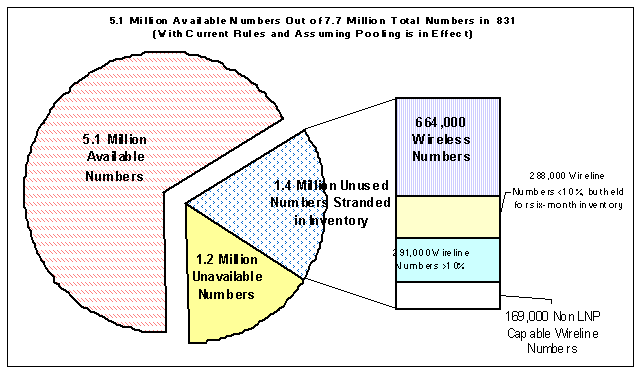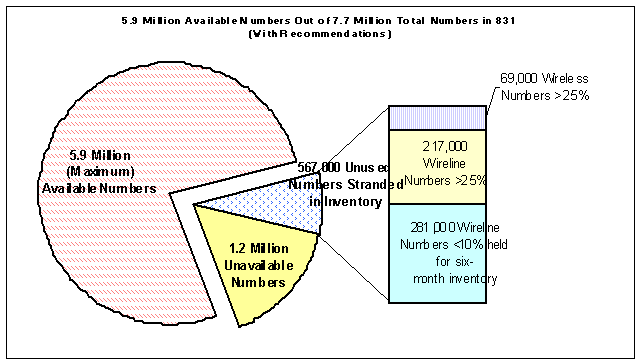Before The Public Utilities Commission Of The State Of California
Order Instituting Rulemaking on the Commission's own Motion Into Competition for Local Exchange Service. |
R.95-04-043 (Filed April 26, 1995) |
|
Order Instituting Investigation on the Commission's own Motion Into Competition for Local Exchange Service. |
I.95-04-044 (Filed April 26, 1995)
|
REPORT ON THE 831 AREA CODE
Submitted in Compliance with California Public Utilities
Code Section 7937, CPUC Decision 99-12-051, and Administrative Law Judge
Ruling Issued on January 18, 2000
CALIFORNIA PUBLIC UTILITIES COMMISSION
TELECOMMUNICATIONS DIVISION
Respectfully submitted
December 21, 2001
Jack Leutza, Director
Telecommunications Division
505 Van Ness Avenue, 3rd Floor
San Francisco, CA 94102
REPORT ON THE 831 AREA CODE
CALIFORNIA PUBLIC UTILITIES COMMISSION
TELECOMMUNICATIONS DIVISION
December 21, 2001
Prepared by Telecommunications Division:
Michael Amato Michaela Pangilinan
Robert Benjamin Craig Stevens
Mary Jo Borak Karen Watts-Zagha
Cherrie Conner
Jack Leutza
TABLE OF CONTENTS
Page
EXECUTIVE SUMMARY 1
CHAPTER ONE: OVERVIEW OF NUMBERING 6
A. Inefficient Use and Increasing Demand for New Numbers in California Is Causing Area Code Proliferation 6
B. 831 History and CPUC Decisions 7
1. Code Administration Allocates Prefixes 8
C. CPUC Efforts to Resolve Area Code Proliferation 9
1. Number Pooling 9
2. Improved Number Inventory Management 10
3. CPUC Efforts at Federal Level 11
4. Utilization Studies 14
CHAPTER TWO: 6.5 MILLION UNUSED NUMBERS IN THE 831 AREA CODE 16
A. The Scope of the Utilization Study 16
1. Distribution Statistics of Prefixes 16
2. Companies Reporting 17
3. Non-Reporting Companies 17
B. 6.5 Million Numbers Available in the 831 Area Code 18
C. Analysis of Available Numbers 21
1. Analysis of Wireline Carriers' Contamination Rates 21
2. Analysis of Wireless Carriers' Contamination Rates 23
3. Potential Block Contamination Abuses 25
4. Reclamation of Prefixes 26
D. Analysis of 1.2 Million Unavailable Numbers 27
1. 886,000 Assigned Numbers 28
2. Reserved Numbers Are a Potential Source of Additional Numbers 32
3. Restrictions on Administrative Numbers Could Yield More Numbers 34
4. Intermediate Numbers 35
5. Aging Numbers 38
6. The Need to Audit the Data 39
CHAPTER THREE: NUMBER POOLING AND OTHER NUMBER CONSERVATION MEASURES 40
A. Introduction 40
B. Number Pooling 40
1. More Accurate Forecasting Will Improve Number Pooling 41
C. Lack of Local Number Portability Stands as a Key Barrier to Pooling 42
D. Unassigned Number Porting 43
E. Consolidation of Rate Centers to Maximize Number Use 44
F. Sharing Prefixes May Yield More Efficient Number Use 47
CONCLUSION 48
APPENDICES 50
EXECUTIVE SUMMARY
Like much of the country, California is currently experiencing a numbering crisis. From 1947 to January 1997, the number of area codes in this state increased gradually from 3 to 13. However, during the next three years, the number of area codes in California nearly doubled. By the end of 1999, California had 25 area codes. Recently, the California Public Utilities Commission (CPUC) has implemented several conservation measures to ensure the efficient use of telephone numbers. Without the implementation of these number conservation measures, the telecommunications industry had plans underway to add 22 more area codes in California by the end of 2003, which could have resulted in a statewide total of 47 area codes.
This study recounts the origin of the 831 area code in July 1998. The 831 area code was a result of the 408 area code split, and the 408 area code was split from the 415 area code. The 831 area code currently serves the Santa Cruz, Salinas, and Monterey areas. However, this report should be viewed in a broader context than the facts pertaining solely to the 831 area code. Moreover, it evaluates the status of number availability in the 831 area code, and discusses the various state and federal policies which govern number use in California and nationwide. In addition, the report analyzes number usage by carrier category and identifies measures that the CPUC can employ in the 831 and other area codes to improve the efficiency of number usage thus, avoiding the premature creation of new area codes. Data is self-reported by the companies; the CPUC staff has not audited any of the 831 utilization data submitted for this study and report.
The utilization study sheds new light on the numbering crisis in the 831 area code. The data reveals that despite increasing demand for numbers, the 831 area code is not fully utilized. Moreover, the study found that approximately 6.5 million of the 7.7 million useable numbers in the 831 area code are not in use. The data further establishes that the 831 area code possesses considerable room for growth, hence aggressive measures such as splits or overlays are not yet warranted in the 831 area code. The report further urges the CPUC to seek from the FCC authority to implement Unassigned Number Porting (UNP) as a means to more efficiently use numbers still available in the 831 area code.
This report is filed in compliance with CPUC Decision (D.) 99-12-051 and AB 406, enacted by the California Legislature in the 1999 legislative session (Chapter 99-809, 1999.). AB 406, codified as Public Utilities Code Section 7937, requires the CPUC to obtain historical telephone number use data from every telecommunications company in California. The CPUC's Telecommunications Division (TD) first obtained and analyzed data from the 310 area code in Los Angeles late in 1999, and produced a utilization report on 310 in March, 2000. In November 2000, TD completed utilization reports covering the 415, 510, 818, and 909 area codes, and in March 2001 TD completed utilization reports covering the 408, 619, 650, and 714 area codes. In May 2001, TD released another four reports covering the 323, 562, 916, and 925 area codes. In July 2001, TD released additional reports that analyze the 626, 707, 805, and 949 area codes. Then in October 2001, TD released the reports for the 209, 213, 760, and 858 area codes. This report on the 831 area code continues TD's analysis covering number utilization levels in specific area codes.
BACKGROUND
The FCC defines unavailable numbers as those already in use or designated for some present or future use. They are grouped into these six categories: assigned, administrative, reserved, intermediate, aging, or codes for special use. Telecommunications companies obtain available numbers from the North American Numbering Plan Administrator (NANPA),1 and in turn, assign those numbers to their customers for immediate use thereby making them assigned numbers. However, if a telecommunications carrier has set aside a number for a specific customer request then those numbers are referred to as reserved numbers. Alternatively, companies may reserve numbers for future use or retain numbers for some internal (administrative) use. Then, there are some companies that provide blocks of numbers to resellers or "dealers" whereby the resellers assign those "intermediate" numbers provided to them to customers. In addition, each assigned number, after disconnection, must "age" during a transition period before assignment to the next customer so those are referred to aging numbers. Finally, some numbers are not available for public use because they have been set aside for emergency purposes, technical network support, or other reasons; and they are known as special-use codes.
FINDINGS
TD's analysis shows that 4.6 million out of the 6.5 million available numbers are available from the Code Administration, and none have been set aside for donation to the future 831 number pool.2 Therefore, companies possess approximately 1.9 million numbers. Wireline carriers such as Pacific Bell and many competitive local exchange carriers hold roughly 1.2 million available numbers while wireless and Type 1 carriers have approximately 700,000 available numbers. At the same time, the 831 study finds about 1.4 million of the numbers held by companies cannot be contributed to the future 831 number pool for reassignment to other companies because the FCC has determined that wireless carriers do not have to participate in number pools at this time.3
The FCC has determined that the CPUC may only require wireline carriers to contribute blocks of 1,000 numbers that are 10% or less contaminated to a number pool,4 meaning those blocks in which only 100 or fewer numbers are unavailable. However, wireline carriers may also keep a portion of the 10% or less contaminated blocks if they need to use those blocks within six months. Therefore, 1.4 million numbers in the 831 area code are available only to the companies holding those numbers because they are held by wireless carriers, located in blocks that are more than 10% contaminated, or contained in blocks 10% or less contaminated but kept for the six-month inventory.
Also, the study concluded that about 5.9 million out of the 6.5 million numbers that are not in use could be made available to companies through pooling if (a) the companies were required to donate blocks with higher contamination levels to the future pool, and (b) wireless carriers were required to participate in the 831 number pool. The first table below illustrates the current distribution of numbers. The second table shows the distribution that would occur if all the recommendations in this report were implemented.


Finally, the study notes that companies identify 1.2 million numbers as unavailable. TD staff recommends specific measures the CPUC can employ to ensure that companies use those "unavailable" numbers more efficiently. Given the near doubling of the number of area codes in California from 1996 to 1999, this vital public resource should be used as efficiently and effectively as possible. The CPUC and the telecommunications industry should strive to minimize the quantity of numbers left "stranded" in company inventories. The 831 Area Code Report recommendations are summarized in Appendix I.
1 NANPA is an entity currently managed by NeuStar, Inc. The FCC chose NeuStar, formerly Lockheed Martin, to perform the functions of numbering administration and area code changes nationwide. 2 Historically, telephone numbers have been allocated to companies in blocks of 10,000, as a complete prefix, such as (831) 703-XXXX. Number pooling allows companies to obtain numbers in blocks of 1,000 or even fewer numbers. 3 At present, only wireline carriers are required to participate in number pooling. The FCC has granted most wireless carriers an extension of time, until November 2002, to implement the technology that will support number pooling. The FCC has permanently exempted paging companies from implementing the technology necessary to pool. 4 The percentage of numbers in use in a particular block of 1,000 numbers is referred to as the "contamination" level.